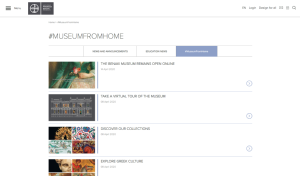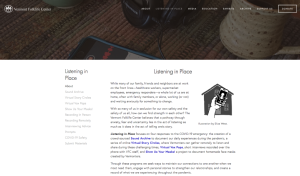General Interest
Back to Top
|
 |
|
Getty Artworks Recreated with Household Items by Creative Geniuses the World Over
|
Arts |
|
No doubt many readers have seen images on Facebook of clever people in quarantine posing with common household objects to recreate well-known masterpieces from the collections of the Rijksmuseum in Amsterdam and the Getty Museum in California. Posted on Getty's blog The Iris on March 30, 2020, this article explains the genesis of all those images. The trend began with a challenge from the Rijksmuseum that the Getty adapted to make it possible for people to use digitized and downloadable artworks from the Getty's online collection. There are a few examples embedded in the blog post, such as a Renaissance manuscript in watercolor, gold and silver paint, and ink on parchment, reimagined by the Martinez family using lasagna, matches, eggs, fruit and vegetables, and a paper bag; or Ann Zumhagen-Krause and her husband's recreation of Vermeer's The Astronomer. The real trove of images can be found on Instagram, using either the English hashtag #betweenartandquarantine or the Dutch version, #tussenkunstenquarataine. Up for the challenge? Have some fun and add your own creative contribution. [DS] |
|





|
|
 |
|
COVID-19 and Climate Change: Graphing the Connection
|
Science |
|
As educators continue to adapt to virtual classrooms, topical and tech-friendly lesson plans are especially important. High school health, science, and social studies educators may enjoy this lesson plan, "COVID-19 and Climate Change: Graphing the Connection," for those very reasons. As the name suggests, the plan draws connections between the current realities of the COVID-19 pandemic and the "future impacts" of climate change on our environment. The lesson uses materials from four news sources: Weather Underground, The New York Times, InsideClimate News, and Bloomberg News. These media sources are a launching point for analysis and discussion of the relationship between health crises and climate change, as well as the media's role in portraying this relationship. Both materials needed for the hour-long activity (an Activity Plan and Student Handout) are freely available to download at the link above with the creation of a free account. Also included in the lesson plan is a one-page handout, "Tips for Online Learning Using Project Look Sharp's Free Lessons and Materials" that offers guidance for virtual learning (applicable to this lesson and beyond), as well as a guide on "How to Use These Materials." Designed by Sox Sperry for Project Look Sharp (a project of Ithaca College), this lesson plan is an extension of the organization's mission to expand civic engagement and media literacy. [EMB] |
|





|
|
 |
|
Storyline Online
|
Language Arts |
|
Providing a sweet story for the kids in your life and a sweet break for the caregivers, Storytime Online is a win-win. A project of the SAG-AFTRA Foundation, this award-winning site offers just what you would expect from the title: a virtual storytelling experience. The site curates videos of celebrities reading famous children's books, accompanied by animations that bring the books to life. For example, viewers can enjoy comedian Sarah Silverman reading A Tale of Two Beasts (a story about unlikely friendships and differing perspectives), and actor Chris Pine reading Clark the Shark (a story about a joyful fish who uses clever rhymes to control his enthusiasm). Stories are selected for all elementary school age levels (and tagged with the appropriate age level in the description). In addition to the animated videos, stories are accompanied by an activity guide that expands on themes presented in the books. On the All Books page, visitors can sort through the abundance of stories and filter by author, reader, title, or run time (most are under 10 minutes). While the whole site is widely and globally visited each year, the stories are an especially excellent resource for families looking to keep children entertained while sheltering in place. [EMB] |
|





|
|
 |
|
Benaki Museum: Museum From Home
|
Arts |
|
One upside to many museums closing their doors in response to the COVID-19 pandemic is that virtual exhibits are surging in popularity. Inviting visitors to #MuseumFromHome, the Benaki Museum (physically located in Athens, Greece) offers wonderful virtual explorations of many of their campuses and galleries. At the link above, visitors can select an exhibit or collection of interest (perhaps you want to discover Greek culture and history, or maybe dive into Islamic Art). These virtual tours (found under The Benaki Museum Remains Open Online) provide a nearly-authentic visit experience from the comfort of the couch, inviting users to toggle over floor plans, virtually walk through the buildings, and check out online captures of materials. After opening a virtual tour, readers can use the arrow controls located at the bottom right side of the screen to navigate. For a simplified experience navigate to the Collections & Archives page (accessible using the menu at the top left of the site). Here visitors will find several subjects to choose from, including Prehistoric, Ancient Greek, and Roman Art and Post-Byzantine and Neo-Hellenic Art. Looking for an amplified experience? Try the audio tours available for four of the museum exhibits, found on the Take a Virtual Tour of the Museum page. These audio tours are currently offered in Greek, English, French, Spanish, Russian, and Chinese. [EMB] |
|





|
|
 |
|
NPR: Short Wave
|
Science |
|
Tune into one of NPR's newest podcasts, Short Wave, for a scientific spin on daily news. New episodes are released every weekday, each averaging around 10 minutes in length. Short Wave allows listeners to develop a more complex understanding of today's headlines, with time to spare. Madeline Sofia hosts the podcast, building on her previous work at NPR. Prior to this position, she hosted the video series Maddie About Science and co-developed the international NPR Scicommers program, which encourages scientists to develop and use communication skills. Short Wave episodes bring listeners "science on a different wavelength," helping audiences better understand the world around them as Sofia and expert guests explore various fascinating topics. Recently, the show celebrated Earth Day's 50th anniversary (in the April 21, 2020 episode), explored disease models and other topics concerning the COVID-19 pandemic (see the April 24, 2020 and April 27, 2020 episodes), and debunked animal science, from birds (April 22, 2020 episode) to fireflies (April 28, 2020 episode). Listeners can find all Short Wave's installments released since its October 2019 launch at the link above, as well as on NPR One, Apple Podcasts, Google Podcasts, Spotify, and more. [SMH] |
|





|
|

















